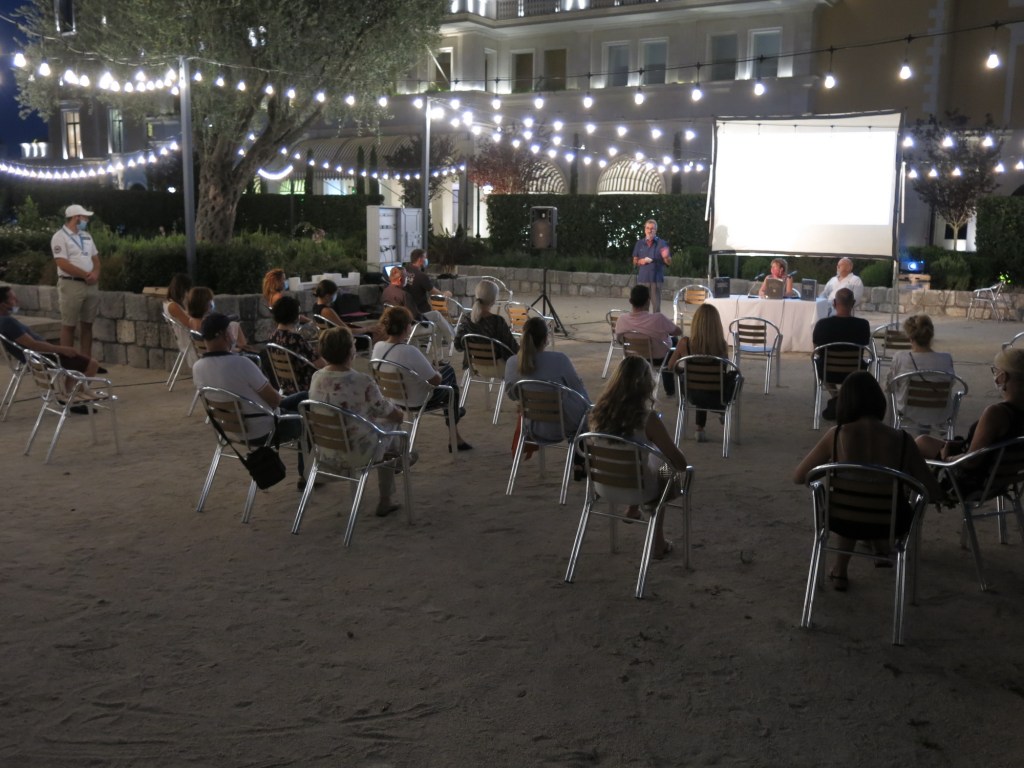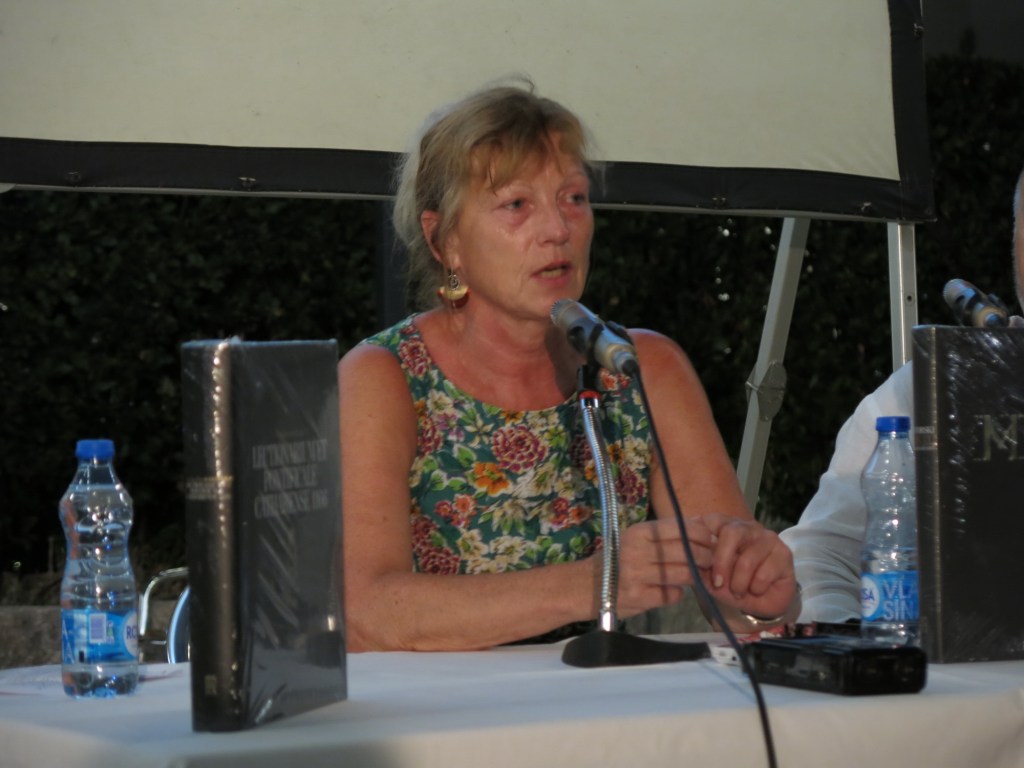August 25, 2020 - The monograph Lectionarium et Pontificale Catharense - Lectionary and Pontifical of the Diocese of Kotor in 1166 by Dr Lenka Blehova Čelebić, was presented last night in the summer garden of the Regent Porto Montenegro Hotel, organized by the Public Institution Cultural Center Tivat.
Lectionarium et Pontificale Catharense - Lectionary and Pontifical of the Diocese of Kotor in 1166 is the oldest manuscript in Montenegro. It is a temporal, cultural, and historical capsule that preserves Kotor alongside the oldest European cultures, said Zvonimir Deković on behalf of the monograph's publisher, The Croatian National Council of Montenegro.
"They didn't believe that I would be able to convince Dr Blehova Čelebić to embark on this venture. I guess the stars were kind to us. She was the only one who could rise to such a task, and for that I thank her sincerely. It makes us especially proud that after so many years since its discovery in St. Petersburg, we have had the honor of returning the Pontifical in a phototype edition, supplemented with a scientific apparatus, to the place in which it belongs. The Croatian National Council is preparing two more books of a liturgical character - the Bar Missal from 1324 and the last Roman Missal from 1906. We want to encourage other authors in this endeavor," said Zvonimir Deković.

Monoghaph presentation, Regent Porto Montenegro, Photo by Dragan Redžo
The Pontifical of the Diocese of Kotor belongs to the Western cultural tradition and it was created when the West was still half a desert: the middle of the 12th century. When Europe was "a minefield, full of heresies and heretics," the teachings of the highest religious and cultural authorities were being interpreted in diminutive Kotor.
The monumental illustrated monograph (29 x 25 cm) consists of 404 pages of phototype edition of the original manuscript, and 100 pages of the author's text, with interpretations and critical apparatus on each page, with bibliography and scientific equipment in twelve languages.
It is not known for sure where the manuscript was made, whether in one of the Beneventan monasteries in Southern Italy, or possibly in a scriptorium in the Bay of Kotor, but it is certain that the indications in the scientific study provided with this edition shed light on the problem and potential answers. No manuscript in this part of the world predates Gutenberg's press by as much as this one - a full 300 years.
The book consists of 404 pages, 100 pages of authored text, a bibliography, and a scientific apparatus in 12 languages. The author found over a thousand Bible quotations in the original text and published them on the margin next to the handwritten original.
"Lenka received a recommendation for research twenty years ago in Argentina from today's Pope Francis. Life and science work in strange ways to provide access to such things. It is wonderful that the book is back. We don't know how the books got separated. Others did not fare any better. This book is one of the few and largest in the Russian Academy - a small contribution from the Bay of Kotor. We may not even be aware of the significance of this book. It is significant European heritage. That is why we have such great respect for what Lenka Blehova Čelebić did with her authority and knowledge, as well as for the Croatian National Council's initiative," said literature professor Neven Staničić.
"I will not talk about the spiritual value of this publication, but the material value is also high. Back then, it was like having a villa with a pool. Not everyone could have this book. In the 12th century, the thoughts of St. Augustine, Gregory the Great, Thomas Aquinas, and others were heard in Kotor. They were discussed daily in our small Kotor, in the Bay of Kotor itself. That is why this is a world heritage treasure. We have returned part of that wealth home, which makes us proud," said Neven Staničić.
Lenka Blehova Čelebić thanked the Croatian National Council and Zvonimir Deković for their understanding and support. She also thanked Neven Staničić for his unfailing assistance, emphasizing that it is not only essential to have a writer for the book, but also to have a team to work with, which contributes to the success of the work, particularly the excellent graphic artists and printers from Novi Sad.

Lenka Blehova Čelebić, Photo by Dragan Redžo
"Last year we promoted the Missal. The Missal is a book that contains the texts and procedures of the Mass. It contains various readings that are mostly passages from the Bible. But it also contains the decisions of the Council of the Catholic Church. This liturgical book is composed of two parts, the Lectionary, and the Pontifical. The Pontifical is a book that contains all the procedures that the bishop must perform. These include the abbots' appointments, the reception of priests, the consecration of cemeteries and churches, etc. All these activities were significant for a bishop who had great authority and important duties. These two books were sewn into one. We don't know why, but we can only guess. We see that this book was made by many hands, several generations of scribes. The third unit in this valuable manuscript is a transcript of the sermons of the great church fathers. The fourth unit is the Kotor Charter and the provisions of the Statute. They were also written on the margins, in empty spaces, of which there were not many. It was important for someone not to forget. There are a lot of interesting things. For the people from Boka Kotorska, this book is not only beautiful but also useful. There is a lot of historical information, musical information, and information from the sphere of diplomacy," the author emphasized.
In the 18th century, the book was still in Kotor. But then it somehow reached St. Petersburg, as the property of a local Catholic seminary.
"We do not know who brought the book from Kotor to St. Petersburg. It was probably in the midst of the Turkish wars. Maybe the person in question wanted to save it from being destroyed by fire," explained the monograph's author, Lenka Blehova Čelebić, at last night's presentation of the publication.
"I did my best to make the book interesting for the layman as well. I tried to make the text readable because it is part of Montenegrin heritage. The monograph is dedicated to Don Anton Belan, who was my very dear collaborator. I have had the honor of working with him ever since I came to Montenegro in 1993, " said Lenka Blehova Čelebić.








